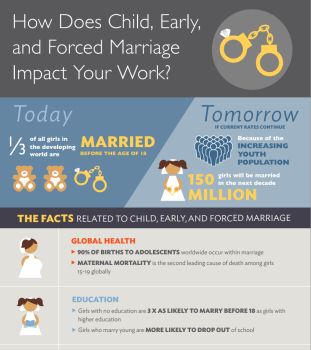
Top 5 ways to use the child, early and forced marriage resource guide
Media Contact
This fall, the world adopted the next development framework, the Sustainable Development Goals (SDGs), which will shape the trajectory of global aid flows for the next 15 years. The international community has embraced ending child marriage as a global priority. As a result, one of the SDG goals included a target to eradicate child marriage and FGM/C, among other harmful traditional practices by 2030. Success or failure of each of the global goals will be measured against targets like the one on child marriage.
In response to this growing momentum, as well as recognition that child marriage is a complex issue that requires a multi-sectoral response, the United States Agency for International Development (USAID), ICRW and Banyan Global worked together to develop the Child, Early, and Forced marriage (CEFM) Resource Guide, which provides guidance on how CEFM prevention and response can be integrated into key programming sectors and strategies.
While the Guide was developed for USAID, it can easily be used by development practitioners, policy-makers, and anyone interested in learning more about how they can tackle child marriage in existing programming.
CEFM is affected by and affects all aspects of a girl’s life. In order to effectively prevent and respond to it, efforts must be incorporated throughout programming in various sectors. This is not just a “gender” issue, but rather something that touches on all areas of development and thus is relevant to practitioners in every field.
Below are some of the main ways development practitioners and policy makers can use the Guide to integrate CEFM prevention and response efforts into programming and policies:
- To better understand what CEFM is, who it affects, and how prevalent it is: The Guide provides a thorough overview of the scope of the CEFM, its causes and consequences, where it occurs, and why it matters.
- To learn about solutions to prevent and respond to CEFM: The Guide provides evidence on the most effective, evidence-based approaches to address CEFM. CEFM is a cross-cutting issue that cannot be solved by efforts within any one sector. Therefore, prevention and response efforts should be integrated across various sectors to create a comprehensive strategy for preventing CEFM, mitigating its effects, and meeting the needs of married adolescents.
- To identify ways to integrate CEFM prevention and response into various key programmatic sectors: The bulk of the Guide focuses on providing guidance to program implementers on how to integrate CEFM prevention and response into their programming. Specifically, the Guide contains sections on integrating CEFM prevention and response into the following key sectors: gender-based violence; youth; global health; education; economic growth and workforce development; agriculture and food security; democracy, human rights and governance; crisis and conflict; and multi-sectoral programming. These sections walk the reader through the connections between that sector and CEFM, how preventing and responding to CEFM can actually help the sector achieve its goals, and where programs within the sector may be able to integrate CEFM prevention and/or response to achieve greater impact.
- To track progress on outcomes related to CEFM: The Guide includes specific indicators to better understand the CEFM context in various settings and for measuring changes in CEFM outcomes. These indicators can be used by dedicated CEFM programs or incorporated into sectoral programs to measure impact on outcomes related to CEFM prevention or response.
- To find more CEFM-related information, resources, and tools: There is a curated list of key resources used to create the Guide. These resources include U.S. Government and international policy documents, USAID strategy documents, and a list of seminal publications containing CEFM research, program evaluations and policy guidance. The Guide also provides a list of existing toolkits, manuals and guides for sector-specific programming. Tools listed contain useful and relevant guidance to design approaches that integrate CEFM prevention and response into programming. And finally, the guide also includes a media kit with social media strategies and key messages on both the Guide and CEFM. The media kit also includes an info-graphic on CEFM.
Given the prevalence of child, early, and forced marriage around the world, as well as how this human rights violation affects the lives of girls and entire communities, we hope USAID and other program implementers will find this a valuable tool in tackling CEFM where it exists.

